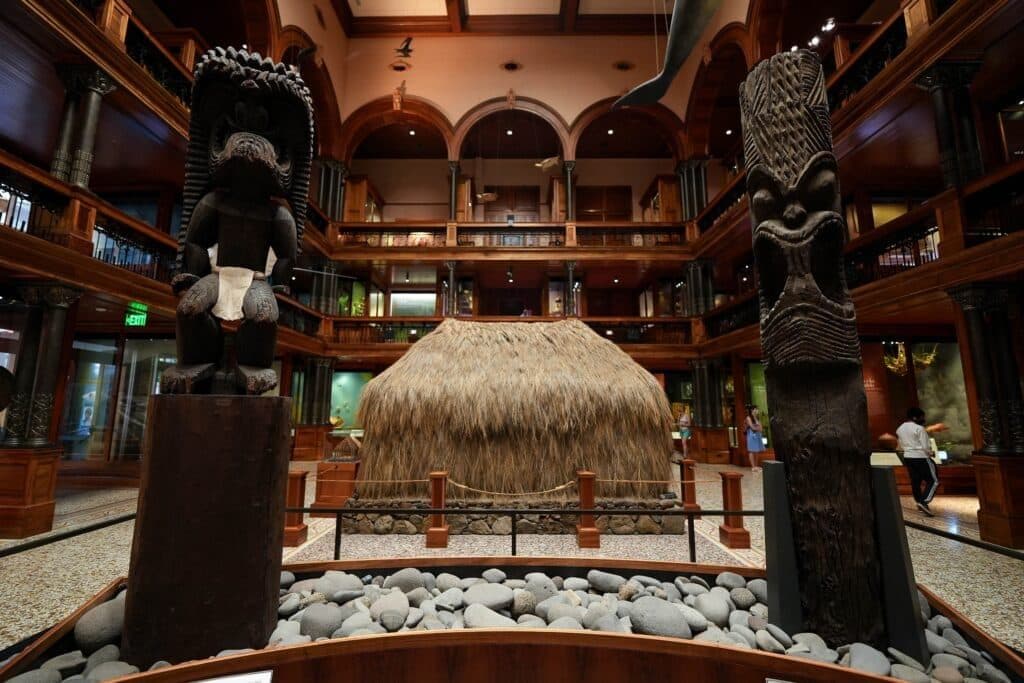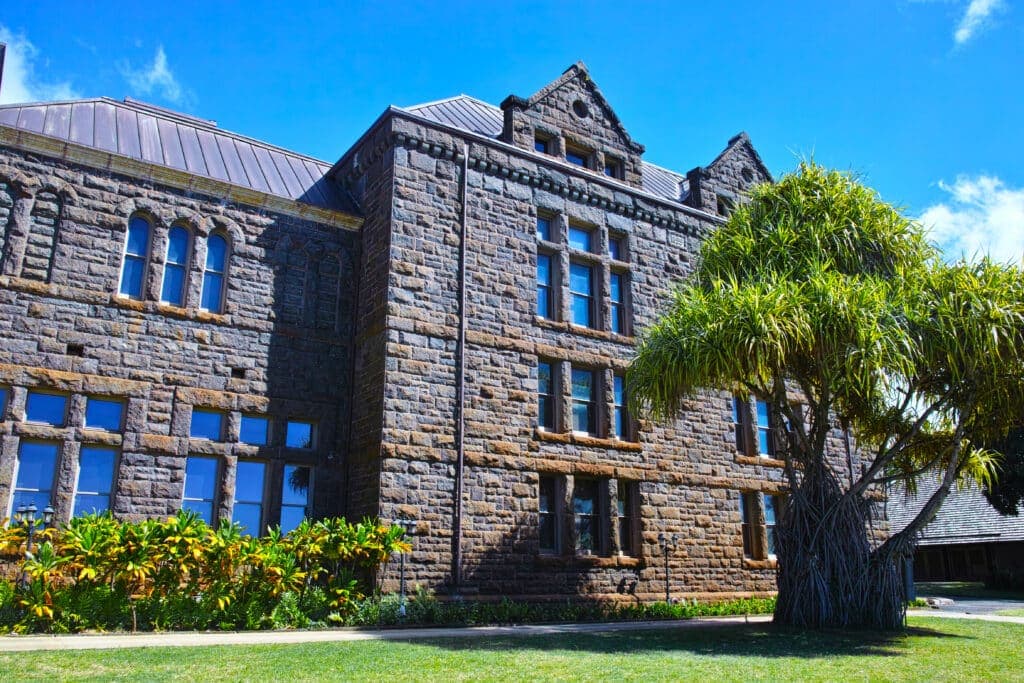By M. Kruse
If you’re planning a trip to Oʻahu and want to dive deeper into Hawaiʻi’s history and culture, the Bishop Museum is a must-visit. Officially called the Bernice Pauahi Bishop Museum, this iconic destination blends science, nature, and the rich traditions of the Hawaiian people all under one roof, featuring an extensive collection of artifacts and documents.
The museum’s collection plays a crucial role in preserving Native Hawaiian culture, showcasing royal heirlooms and items that illustrate the lives of ancient Hawaiians and their connection to the broader Polynesian culture.
For my family, visiting the Bishop Museum is a tradition. It’s the first place we go when we have relatives visiting or want to spend a meaningful day together. My kids absolutely adore the Science Adventure Center where the centerpiece is an immersive, three-story erupting volcano. They could spend hours crawling through the simulated lava tube, watching the bubbling volcano demo, and exploring marine life displays. It’s one of the few places where learning and play go hand in hand — and it never feels like a chore. No matter how many times we visit, there’s always something new to discover, which is why it remains our favorite activity on Oʻahu.
Here’s your complete guide to experiencing the Bishop Museum Hawaiʻi: what to see, when to go, how to get there, and tips to make your visit unforgettable.

Interior of the Hawaiian Hall of the Bishop Museum, the largest museum of Hawaii in Honolulu (Shutterstock)
Founded in 1889 by Charles Reed Bishop in honor of his late wife Princess Bernice Pauahi Bishop, the Bishop Museum was created to preserve and share the history of Hawaiʻi. Today, it’s the largest museum in the state and the premier natural and cultural history institution in the Pacific.
The museum also houses royal family heirlooms that belonged to Princess Bernice Pauahi Bishop, a descendant of the royal Kamehameha family. Known officially as the Bishop Museum of Science and Nature, this Oʻahu gem holds millions of artifacts, photographs, and documents. It’s where culture meets curiosity.

Interior of the Hawaiian Hall of the Bishop Museum, the largest museum of Hawaii in Honolulu on the island of Oahu
This three-story gallery is the heart and soul of the museum. The moment you step inside, you’re surrounded by the scent of old koa wood and the deep mana (spiritual energy) of the islands. On the first floor, you’ll find exhibits on gods and legends, including wooden kiʻi (images of deities) and items used in ancient ceremonies.
The second floor focuses on daily life in old Hawaiʻi, from feather cloaks worn by aliʻi (royalty) to fishhooks and tapa cloth. It also highlights the connections to other Polynesian cultures, emphasizing the broader cultural context of the exhibits. The top level ties it all together with modern perspectives on how these traditions continue to influence island life today. The space itself — tall ceilings, stained glass, and native hardwoods — feels like a sacred place.
Pacific Hall explores the interconnected cultures of Oceania, including Polynesian cultures, Micronesia, and Melanesia. The craftsmanship on display is extraordinary — from intricately carved wooden tools and musical instruments to full-sized outrigger canoes.
Interactive displays explain ancient navigation techniques using the stars, wind, and ocean swells. Children and adults alike are fascinated by the detailed models of traditional village life. This hall helps visitors understand how vast and yet culturally connected the Pacific really is. It’s a reminder of the shared ancestry that links Hawaiʻi to its Pacific neighbors.
A favorite for families, this hands-on building features interactive exhibits that are a wonderland of discovery. My kids rush straight to the erupting volcano model, where they can see how magma moves beneath the surface. There’s a walk-through lava tube, a life-size model of a deep-sea submersible, and engaging displays on marine biology and native species.
The second floor takes you into space with star maps and a look at Hawaiian contributions to modern astronomy. It’s a place that blends science with storytelling, making complex subjects exciting and easy to grasp. Every time we visit, we leave with a new fun fact or curiosity sparked.
This dome theater is more than just a star show. The Bishop Museum’s planetarium focuses on the wayfinding skills of Polynesian voyagers. Shows highlight how early Hawaiians used the stars to navigate thousands of miles across the open ocean long before GPS existed.
One of the most popular shows is “Wayfinders: Waves, Winds, and Stars,” which tells the story of Hōkūleʻa, the voyaging canoe that sparked a cultural renaissance in Hawaiʻi. Comfortable seating and stunning visuals make this a peaceful break during your museum visit, and it’s a great way to deepen your appreciation for Hawaiian ingenuity.
This open-air cultural space hosts live demonstrations and workshops that bring the museum’s exhibits to life. Depending on when you visit, you might catch hula performances, lei-making classes, or talks from local cultural practitioners.
The Atherton Hālau offers a chance to interact directly with Hawaiian traditions. It’s a favorite spot for visitors who want to go beyond observing and start participating. Kids can try out traditional games, while adults enjoy learning about the significance of flowers, music, and movement in Hawaiian culture.
The Bishop Museum hosts rotating exhibits and seasonal events throughout the year. Recent highlights have included:
POW! WOW! The First Decade: From Hawaiʻi to the World, featuring street art from the global art movement born in Kakaʻako.
Ola Ka Noʻeau: Excellence in Hawaiian Artistry, celebrating traditional craftsmanship.
In addition to these events, the museum’s vast collections of natural history specimens, including millions of entomological and other biological items, play a significant role in its research legacy and educational impact.
Check their event calendar to see what’s going on during your visit.
“We went for one hour and stayed for four. So much to see!” – @travelohana on Twitter

Bishop Museum in Honolulu (Shutterstock)
Traveling with kids? The Bishop Museum Oʻahu is super family-friendly:
The Science Adventure Center has interactive volcano simulations.
The Lawn Museum is perfect for running around or enjoying a picnic.
Keiki (kids) programs during breaks and holidays keep young ones entertained.
Here are more tips to make your visit even better:
Pack snacks and water. While there’s a small café and food trucks on-site during some events, having your own supplies ensures your kids stay energized.
Bring sunscreen and hats. Much of the museum is outdoors or semi-outdoor, especially the lawn and Atherton Hālau area.
Use the map. The museum can be a bit of a maze for first-timers. Grab a printed map at the entrance or use the QR code to access a digital one.
Time your visit right. The museum opens at 9 a.m. Arrive early to avoid the midday rush. The planetarium and cultural demos are scheduled throughout the day, so check the schedule when you arrive.
Visit during school breaks. Bishop Museum runs special family-focused programming and pop-up events during spring break, summer, and winter holidays. These include craft stations, storytelling circles, and even appearances by local performers.
Plan to spend at least 3-4 hours exploring. Even if you think you can breeze through the museum in an hour, there’s a lot to see. Set aside a good portion of your day.
Combine your visit with nearby stops. Pair a day at the museum with a drive through nearby Kalihi or lunch in Chinatown. Both are short rides away and offer tasty local eats.
Check out the Best Museums in Hawaiʻi for other cultural stops across the islands.
Browse Oʻahu’s Top Attractions to round out your day.
“My kids LOVED the lava tube and learning about Pele. Hands-on and educational!” – @islandmom808 on Instagram
Bishop Museum Tickets:
Adults (18+): $33.95
Youth (4-17): $25.95
Children under 4: Free
Kamaʻāina & Military discounts available
Tickets can be purchased online in advance
Onsite parking is available for $16 per vehicle, or $8 for Hawai’i residents.
Street parking is limited, so arriving early helps!
Located just north of downtown Honolulu, the museum is:
15 minutes from Waikīkī
Accessible via TheBus (Routes 2 or 13)
Rideshare services like Uber and Lyft are easy and convenient
You can surf and snorkel every day of your trip — but understanding the islands’ roots adds a whole new layer of appreciation. Hawaiʻi’s Bishop Museum brings together centuries of history in a setting that’s both stunning and engaging.
Whether you’re a history buff or just looking for a half-day adventure, the Bishop Museum offers a meaningful break from the beach.
“Didn’t expect to love it so much! Gorgeous grounds, powerful stories. Worth every minute.” – @alohaadventures on Facebook
Join our newsletter for travel inspiration, insider tips and the latest island stories.
By subscribing, you agree to receive emails from Hawaii.com. You can unsubscribe anytime. See our Privacy Policy.